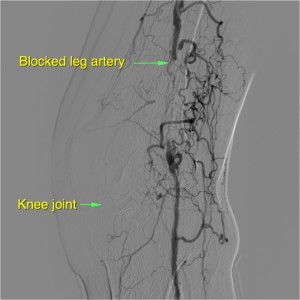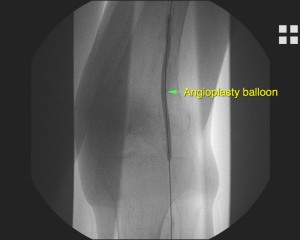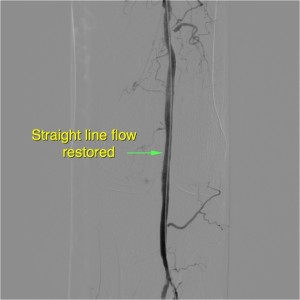Angioplasty Procedure
WHAT IS PERIPHERAL VASCULAR DISEASE?
Atherosclerosis refers to build up of plaque in the wall of an artery due to the deposition of cholesterol and lipids into the walls of arteries. This narrows the arteries, thus limiting the blood supply and therefore the supply of oxygen and nutrition to the downstream organ. This can affect many arteries in the body, including the coronary (heart) and renal (kidney) arteries. It commonly affects the leg arteries.
WHAT ARE THE SYMPTOMS OF PERIPHERAL VASCULAR DISEASE?
One of the initial symptoms of peripheral vascular disease may be claudication. This refers to pain in the legs during exercise or walking up a slope, due to the increased demand of the muscles during exertion outstripping the compromised blood supply. The pain normally resolves after rest.
As the blood supply becomes more compromised, the distance walked prior to claudication decreases. If this compromise becomes critical, pain may occur at rest (rest pain) and clinically this may progress to non-healing ulcers or gangrene.

WHAT ARE THE RISKS OF PERIPHERAL VASCULAR DISEASE?
Risk factors for peripheral vascular disease include smoking, high cholesterol, high blood pressure and obesity. Other medical conditions are risk factors, including heart disease and diabetes. Age is also a risk factor.
WHY TREAT PERIPHERAL VASCULAR DISEASE?
The goal of treatment is to prevent the symptoms of peripheral vascular disease. In cases of claudication, this is to prevent leg pain on exertion or to improve exercise tolerance.
In more severe cases, the goal of treatment is to prevent further tissue loss. That is, to improve blood supply in order to heal any areas of skin break down and to prevent gangrene. In the event of gangrene, the dead tissue will have to be removed. However, blood supply has to be optimised prior to amputation so that the wound will have enough blood supply to adequately heal.
HOW CAN WE TREAT PERIPHERAL VASCULAR DISEASE?
The initial treatment of peripheral vascular disease revolves around optimising the health of the blood vessels. This includes cessation of smoking, control of cholesterol and blood pressure, diabetes management and exercise.

Narrowings (stenoses) or blockages (occlusions) can also be treated using endovascular means if symptoms continue despite conservative management. This is normally done with angioplasty (balloon dilation) and stenting, performed as a day-only procedure.
After local anaesthetic and sedation, the arterial system is accessed, normally via the artery at the top of the leg. This is done via a thin tube 2-3mm in diameter. An angiogram is performed (injection of dye with simultaneous x-ray pictures) to show the location and length of the narrowing. A thin, floppy wire (guide wire) is then navigated across the area of stenosis or occlusion. Once this is achieved, a balloon catheter is advanced over the guide wire and then inflated (angioplasty). After deflation, another angiogram is performed in order to assess the appearance of the artery after dilation. If the artery is still narrowed, a stent may be required.

Stents in the legs are normally “self-expanding”. That is, they have an inbuilt “memory” and continue to push outwards after deployment. They are flexible and act as a metallic “scaffold” to help hold the artery open.
At the end of the procedure, the access point in the artery is normally closed with either manual pressure, a suture or plug. Normally, the patient may be discharged after 2-4 hours observation.
http://www.sirweb.org/patients/angioplasty-stent
http://www.cirse.org/index.php?pid=93

